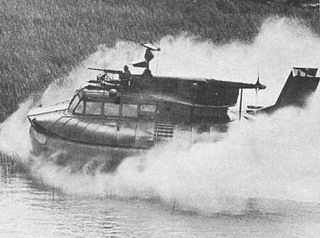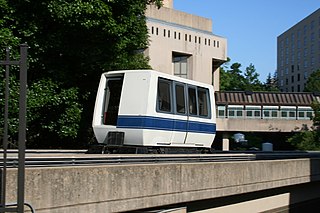Related Research Articles

A hovercraft, also known as an air-cushion vehicle or ACV, is an amphibious craft capable of travelling over land, water, mud, ice, and other surfaces.

The SR.N4 hovercraft was a combined passenger and vehicle-carrying class of hovercraft. The type has the distinction of being the largest civil hovercraft to have ever been put into service.

Sir Christopher Sydney Cockerell CBE RDI FRS was an English engineer, best known as the inventor of the hovercraft.
Cushioncraft Ltd was a British engineering company, formed in 1960 as a division of Britten-Norman Ltd to develop/build hovercraft. Originally based at Bembridge Airport on the Isle of Wight, Cushioncraft later moved to the Duver Works at St. Helens, these works gave ready access to the sheltered water of Bembridge Harbour.

A hover car is a personal vehicle that flies at a constant altitude of up to a few meters (yards) above the ground and used for personal transportation in the same way a modern automobile is employed. The concept usually appears in science fiction.

British Hovercraft Corporation (BHC) was a British hovercraft manufacturer that designed and produced multiple types of vehicles for both commercial and civil purposes.

A surface effect ship (SES) or sidewall hovercraft is a watercraft that has both an air cushion, like a hovercraft, and twin hulls, like a catamaran. When the air cushion is in use, a small portion of the twin hulls remains in the water. When the air cushion is turned off ("off-cushion" or "hull borne"), the full weight of the vessel is supported by the buoyancy of the twin hulls.

The Aérotrain was an experimental Tracked Air Cushion Vehicle (TACV), or hovertrain, developed in France from 1965 to 1977 under the engineering leadership of Jean Bertin (1917–1975) – and intended to bring the French rail network to the cutting edge of land-based public transportation.

A ground effect train is a conceptualized alternative to a magnetic levitation (maglev) train. In both cases the objective is to prevent the vehicle from making contact with the ground. Whereas a maglev train accomplishes this through the use of magnetism, a ground effect train uses an air cushion; either in the manner of a hovercraft or using the "wing-in-ground-effect" design.

Griffon Hoverwork Ltd (GHL) is a British hovercraft designer and manufacturer.

The Saunders-Roe SR.N1 was the first practical hovercraft. The concept has its origins in the work of British engineer and inventor Christopher Cockerell, who succeeded in convincing figures within the services and industry, including those within British manufacturer Saunders-Roe. Research was at one point supported by the Ministry of Defence; this was later provided by the National Research Development Corporation (NRDC), who had seen the potential posed by such a craft.
Melville Whitnel Beardsley was the American inventor and aeronautical engineer whose pioneering efforts may have contributed to the invention of the hovercraft.

A ground-effect vehicle (GEV), also called a wing-in-ground-effect (WIG), ground-effect craft, wingship, flarecraft or ekranoplan, is a vehicle that is able to move over the surface by gaining support from the reactions of the air against the surface of the earth or water. Typically, it is designed to glide over a level surface by making use of ground effect, the aerodynamic interaction between the moving wing and the surface below. Some models can operate over any flat area such as frozen lakes or flat plains similar to a hovercraft.

The Saunders-Roe SR.N5 was a medium-sized hovercraft which first flew in 1964. It has the distinction of being the first production-built hovercraft in the world.

Tracked Hovercraft was an experimental high speed train developed in the United Kingdom during the 1960s. It combined two British inventions, the hovercraft and linear induction motor, in an effort to produce a train system that would provide 250 mph (400 km/h) inter-city service with lowered capital costs compared to other high-speed solutions. Substantially similar to the French Aérotrain and other hovertrain systems of the 1960s, Tracked Hovercraft suffered a similar fate to these projects when it was cancelled as a part of wide budget cuts in 1973.

A hovertrain is a type of high-speed train that replaces conventional steel wheels with hovercraft lift pads, and the conventional railway bed with a paved road-like surface, known as the track or guideway. The concept aims to eliminate rolling resistance and allow very high performance, while also simplifying the infrastructure needed to lay new lines. Hovertrain is a generic term, and the vehicles are more commonly referred to by their project names where they were developed. In the UK they are known as tracked hovercraft, in the US they are tracked air-cushion vehicles. The first hovertrain was developed by Jean Bertin in the early 1960s in France, where they were marketed as the Aérotrain before being abandoned by the French government.
Whiskey Bottom Road is a historic road north of Laurel, Maryland that traverses Anne Arundel and Howard Counties in an area that was first settled by English colonists in the mid-1600s. The road was named in the 1880s in association with one of its residents delivering whiskey after a prohibition vote. With increased residential development after World War II, it was designated a collector road in the 1960s; a community center and park are among the most recent roadside developments.

The Ship-to-Shore Connector (SSC), also known as the LCAC 100 class, is a system proposed by the United States Navy as a replacement for the Landing Craft Air Cushion (LCAC). It will offer an increased capacity to cope with the growing weight of equipment used by the United States Army and Marine Corps. As of 2015, the program is forecast to cost a total of US$4.054B for 73 hovercraft.
William R. Bertelsen was an American inventor who pioneered in the field of air-cushion vehicles (hovercraft). Bertleseb was most notable for being the inventor of the Aeromobile, which is credited as the first hovercraft to carry a human over land and water. In 2002, Bertelsen was named the "Father of the Air Cushion Vehicle" by The World Hovercraft Federation. William R. Bertelsen married Alberta Menzel on September 21, 1946, in Homewood, Illinois.

The LACV-30 was a hovercraft used by the U.S. Army Mobility Equipment Research and Development Command (MERADCOM) for offloading cargo from amphibious ships. For logistic transport, the Army was already using the LARC-V and LARC-LX, huge 4-wheeled vehicles referred to as 'barges on wheels'. The Army used the LACV-30 to transport 20 ft. standard MILVAN containers as well as outsize loads that would not fit on a LARC-V or LARC-LX. MERADCOM operated 24 LACV-30s between 1983 and 1994.
References
- ↑ "Amphibian Vehicle Riding On Air Cushion Is Shown". The Evening Star, Washington, DC. August 4, 1961.
- ↑ "Melville Beardsley - American Inventor of the Air-Cushion Vehicle". Archived from the original on 2011-07-18. Retrieved 2010-05-21.
- ↑ "Air Suspension Vehicles Redied for Quantico Tests". The Free Lance Star. July 27, 1959.
- ↑ "Air Transports of Future Displayed at Conference". The Reading Eagle. October 24, 1959.
- ↑ "Melville Beardsley: A pioneer's impact on hovercraft development" . Retrieved 23 November 2010.